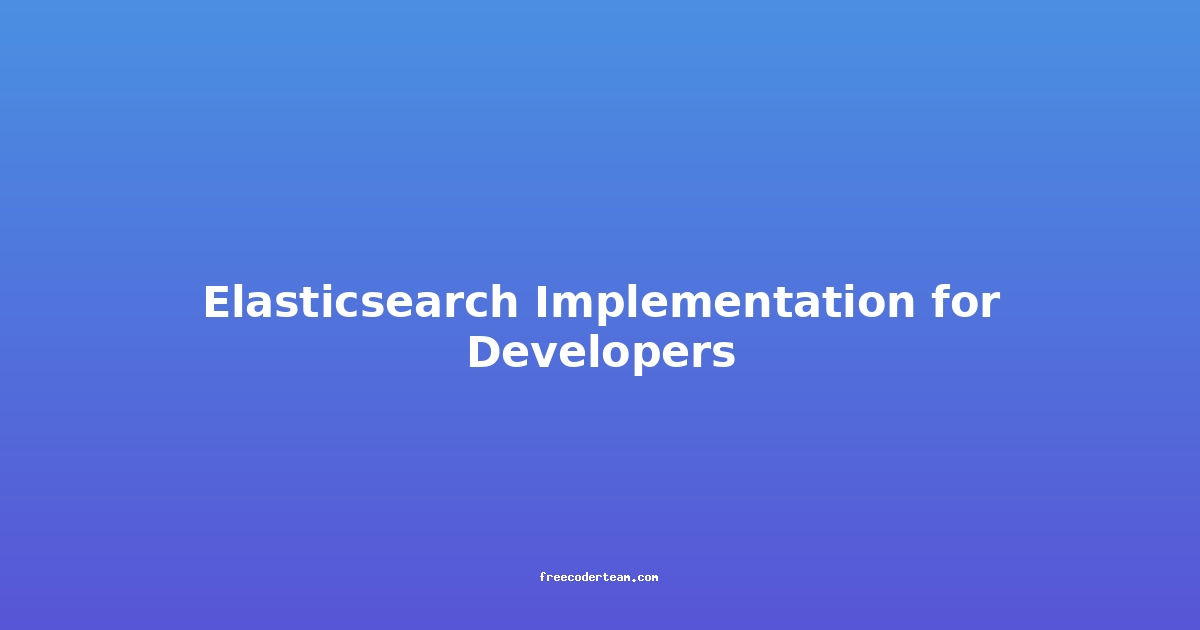Elasticsearch Implementation for Developers: A Comprehensive Guide
Elasticsearch is a powerful, open-source search engine built on top of Apache Lucene. It is widely used for full-text search, analytics, and handling large volumes of data. For developers, understanding how to implement Elasticsearch effectively can significantly enhance the search capabilities of their applications. In this blog post, we will explore the fundamentals of Elasticsearch, best practices for implementation, and practical examples to help you get started.
Table of Contents
- Introduction to Elasticsearch
- Key Concepts in Elasticsearch
- Setting Up Elasticsearch
- Indexing Data
- Searching with Elasticsearch
- Best Practices for Elasticsearch Implementation
- Scalability and Performance
- Monitoring and Troubleshooting
- Conclusion
Introduction to Elasticsearch
Elasticsearch is designed to handle complex search queries efficiently. It is particularly useful for applications that require fast, near-real-time search capabilities, such as e-commerce platforms, content management systems, and log analysis tools. Elasticsearch is part of the Elastic Stack, which includes other tools like Kibana for visualization, Logstash for data ingestion, and Beats for data collection.
Before diving into implementation, it's important to understand the core concepts of Elasticsearch.
Key Concepts in Elasticsearch
1. Cluster
An Elasticsearch cluster is a group of one or more nodes (servers) that work together to store data and provide search capabilities. Each cluster has a unique name, and nodes within the same cluster communicate with each other to distribute data and handle queries.
2. Node
A node is a single server that is part of the cluster. Nodes can store data, handle search requests, or both. You can have multiple nodes in a cluster to improve performance and reliability.
3. Index
An index is a collection of documents that share a similar structure. Think of an index as a database in traditional relational databases. For example, you might have an index for users, another for products, and so on.
4. Document
A document is a piece of data stored in an index. It is similar to a row in a relational database. Documents are typically stored as JSON objects.
5. Mapping
A mapping defines the structure of the documents in an index. It specifies the fields, their data types, and how they should be indexed or stored.
6. Shards and Replicas
- Shards: Elasticsearch automatically splits an index into multiple shards to distribute data across nodes. This improves performance and allows for horizontal scaling.
- Replicas: Replicas are copies of shards that provide redundancy and improve fault tolerance.
Setting Up Elasticsearch
Installation
You can install Elasticsearch on your local machine or deploy it in a cloud environment. Here's how to install it locally:
Using Docker
The easiest way to get started is by using Docker:
docker pull docker.elastic.co/elasticsearch/elasticsearch:7.17.9
docker run -p 9200:9200 -p 9300:9300 -e "discovery.type=single-node" docker.elastic.co/elasticsearch/elasticsearch:7.17.9
This command pulls the Elasticsearch Docker image and runs it with the necessary ports exposed.
Using the Official Installer
You can also download the official installer from the Elastic website.
Indexing Data
Indexing is the process of adding documents to an Elasticsearch index. Let's look at how to create an index and add documents.
Creating an Index
You can create an index using the Elasticsearch REST API. Here's an example using curl:
curl -X PUT "http://localhost:9200/users" -H 'Content-Type: application/json' -d'
{
"settings": {
"number_of_shards": 1,
"number_of_replicas": 0
},
"mappings": {
"properties": {
"name": { "type": "text" },
"age": { "type": "integer" },
"email": { "type": "keyword" }
}
}
}'
This command creates an index named users with specific mappings for fields like name, age, and email.
Adding Documents
Once the index is created, you can add documents to it:
curl -X POST "http://localhost:9200/users/_doc/1" -H 'Content-Type: application/json' -d'
{
"name": "John Doe",
"age": 30,
"email": "john.doe@example.com"
}'
This command adds a document with an ID of 1 to the users index.
Searching with Elasticsearch
Elasticsearch provides powerful search capabilities. You can perform simple or complex queries using the _search API.
Simple Search
To search for documents, you can use the _search endpoint:
curl -X GET "http://localhost:9200/users/_search?q=name:John"
This query searches for documents in the users index where the name field contains the term "John".
Advanced Search
You can also use the Query DSL for more complex queries. For example, to search for users older than 25:
curl -X GET "http://localhost:9200/users/_search" -H 'Content-Type: application/json' -d'
{
"query": {
"range": {
"age": {
"gt": 25
}
}
}
}'
This query uses a range query to find users with an age greater than 25.
Best Practices for Elasticsearch Implementation
1. Define Clear Mappings
Always define mappings for your indices to ensure that Elasticsearch understands how to index and store your data. This improves search performance and ensures consistency.
2. Use Appropriate Data Types
Choose the right data types for your fields. For example, use text for full-text search and keyword for exact matches.
3. Index Only Necessary Fields
Avoid indexing fields that are not needed for search. This reduces storage requirements and improves query performance.
4. Optimize Sharding and Replication
Configure the number of shards and replicas based on your data volume and availability requirements. Too many shards can lead to performance issues, while too few can limit scalability.
5. Monitor and Tune Performance
Regularly monitor your Elasticsearch cluster using tools like Kibana or the Elasticsearch API. Tune settings like heap size, thread pool size, and garbage collection to optimize performance.
Scalability and Performance
Elasticsearch is designed to scale horizontally. To handle large volumes of data:
- Add More Nodes: Increase the number of nodes in your cluster to distribute data and load.
- Use Index Aliases: Manage multiple indices (e.g., for time-based data) using aliases to simplify querying.
- Implement Caching: Use Elasticsearch's built-in caching mechanisms to speed up frequent queries.
Monitoring and Troubleshooting
Monitoring
- Kibana: Use Kibana to visualize cluster health, node metrics, and query performance.
- API Metrics: Monitor Elasticsearch's built-in metrics API to get real-time insights into cluster health and performance.
Troubleshooting
- Slow Queries: Use the
_explainAPI to understand why a query is slow. - Cluster Health: Regularly check the cluster health using the
_cat/healthAPI. - Logs: Enable and monitor Elasticsearch logs to identify issues.
Conclusion
Elasticsearch is a powerful tool for developers looking to implement advanced search capabilities in their applications. By understanding its core concepts, following best practices, and leveraging its scalability and performance features, you can build robust and efficient search solutions.
Whether you're building a simple search feature or a complex analytics platform, Elasticsearch provides the flexibility and power needed to handle a wide range of use cases. Start by experimenting with the basics, and as you gain confidence, explore more advanced features to unlock its full potential.
Resources
By mastering Elasticsearch, you can significantly enhance the user experience of your applications and unlock valuable insights from your data. Happy coding! 🚀
Feel free to reach out if you have any questions or need further assistance!




